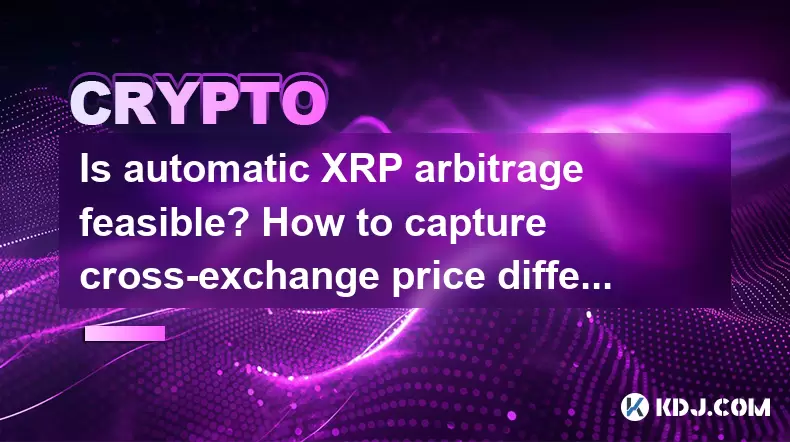-
 Bitcoin
Bitcoin $118600
-2.59% -
 Ethereum
Ethereum $4282
-0.42% -
 XRP
XRP $3.129
-4.21% -
 Tether USDt
Tether USDt $0.0000
0.01% -
 BNB
BNB $805.4
-1.80% -
 Solana
Solana $174.3
-5.77% -
 USDC
USDC $0.9998
-0.01% -
 Dogecoin
Dogecoin $0.2230
-6.33% -
 TRON
TRON $0.3466
1.70% -
 Cardano
Cardano $0.7745
-5.73% -
 Chainlink
Chainlink $21.37
-3.53% -
 Hyperliquid
Hyperliquid $42.93
-7.25% -
 Stellar
Stellar $0.4324
-4.94% -
 Sui
Sui $3.660
-7.17% -
 Bitcoin Cash
Bitcoin Cash $591.6
2.72% -
 Hedera
Hedera $0.2467
-7.04% -
 Ethena USDe
Ethena USDe $1.001
0.00% -
 Avalanche
Avalanche $22.92
-6.14% -
 Litecoin
Litecoin $118.8
-3.79% -
 Toncoin
Toncoin $3.378
-0.46% -
 UNUS SED LEO
UNUS SED LEO $9.011
-1.15% -
 Shiba Inu
Shiba Inu $0.00001294
-5.81% -
 Uniswap
Uniswap $11.24
0.53% -
 Polkadot
Polkadot $3.870
-6.16% -
 Cronos
Cronos $0.1662
-1.68% -
 Dai
Dai $1.000
0.02% -
 Ethena
Ethena $0.7915
-5.62% -
 Bitget Token
Bitget Token $4.414
-1.65% -
 Monero
Monero $259.3
-3.85% -
 Pepe
Pepe $0.00001120
-8.29%
Is automatic XRP arbitrage feasible? How to capture cross-exchange price differences?
Automatic XRP arbitrage is feasible with the right setup, involving fast execution, low transaction costs, and real-time monitoring across exchanges.
May 20, 2025 at 12:21 pm

Is automatic XRP arbitrage feasible? How to capture cross-exchange price differences?
Arbitrage in the cryptocurrency market, particularly with XRP, involves exploiting price differences across various exchanges to generate profit. Automatic XRP arbitrage is indeed feasible, but it requires a deep understanding of both the technical and operational aspects of trading. This article will explore the feasibility of automatic XRP arbitrage and provide a detailed guide on capturing cross-exchange price differences.
Understanding XRP Arbitrage
XRP, the native cryptocurrency of the Ripple network, is traded on numerous exchanges worldwide. Due to factors such as liquidity, trading volume, and market sentiment, XRP prices can vary significantly from one exchange to another. Arbitrage is the practice of buying XRP on an exchange where the price is lower and simultaneously selling it on another exchange where the price is higher. The difference between these prices is the profit margin for the arbitrageur.
Feasibility of Automatic XRP Arbitrage
The feasibility of automatic XRP arbitrage depends on several factors:
- Speed of Execution: Cryptocurrency markets move quickly, and prices can change in a matter of seconds. Automated systems are essential for executing trades fast enough to capture price differences before they disappear.
- Transaction Costs: Each trade incurs fees, including trading fees, withdrawal fees, and deposit fees. These costs can significantly impact the profitability of arbitrage.
- Liquidity: Sufficient liquidity on both the buying and selling exchanges is crucial to ensure that trades can be executed at the desired prices.
- Regulatory Environment: Different jurisdictions have varying regulations regarding cryptocurrency trading, which can affect the feasibility of arbitrage strategies.
Setting Up an Automatic XRP Arbitrage System
To set up an automatic XRP arbitrage system, several steps need to be followed:
- Choose the Right Exchanges: Identify exchanges with significant XRP trading volumes and liquidity. Popular exchanges for XRP include Binance, Coinbase, and Kraken.
- API Integration: Most exchanges offer APIs that allow for automated trading. Integrate these APIs into your arbitrage system to access real-time price data and execute trades.
- Develop the Arbitrage Algorithm: Create an algorithm that continuously monitors XRP prices across selected exchanges. The algorithm should identify profitable opportunities and execute trades automatically.
- Test the System: Before deploying the system with real funds, thoroughly test it in a simulated environment to ensure it functions as expected.
- Monitor and Adjust: Continuously monitor the performance of the arbitrage system and make adjustments as needed to optimize profitability and account for market changes.
Capturing Cross-Exchange Price Differences
To effectively capture cross-exchange price differences, consider the following strategies:
- Real-Time Monitoring: Use real-time data feeds to monitor XRP prices across multiple exchanges. This allows for immediate identification of price discrepancies.
- Order Book Analysis: Analyze the order books of different exchanges to understand the depth of liquidity and potential impact of large trades on prices.
- Risk Management: Implement risk management strategies to protect against potential losses due to sudden market movements or technical failures.
- Latency Optimization: Minimize latency by using servers located close to the exchanges and optimizing the code for faster execution.
Executing an XRP Arbitrage Trade
Here is a step-by-step guide on how to execute an XRP arbitrage trade:
- Identify the Opportunity: Use your arbitrage system to identify a price difference between two exchanges. For example, XRP is trading at $0.50 on Exchange A and $0.52 on Exchange B.
- Calculate Profitability: Determine the potential profit after accounting for all transaction costs. If the profit margin is sufficient, proceed with the trade.
- Execute the Buy Order: Place a buy order for XRP on Exchange A at $0.50.
- Execute the Sell Order: Simultaneously place a sell order for XRP on Exchange B at $0.52.
- Transfer XRP: Once the buy order is filled, transfer the XRP from Exchange A to Exchange B.
- Complete the Trade: Once the XRP is received on Exchange B, the sell order should be executed, completing the arbitrage trade.
Challenges and Considerations
While automatic XRP arbitrage can be profitable, it comes with several challenges and considerations:
- Market Volatility: Cryptocurrency markets are highly volatile, and prices can change rapidly, potentially eroding arbitrage opportunities.
- Technical Failures: Automated systems are susceptible to technical failures, which can result in missed opportunities or financial losses.
- Regulatory Risks: Changes in regulations can impact the legality and feasibility of arbitrage strategies.
- Competition: As more traders engage in arbitrage, the profit margins can decrease due to increased competition.
Frequently Asked Questions
Q: Can I perform XRP arbitrage manually?
A: Yes, manual XRP arbitrage is possible, but it requires constant monitoring of prices across exchanges and quick execution of trades. Automated systems are generally more efficient and can capture more opportunities.
Q: What is the minimum capital required for XRP arbitrage?
A: The minimum capital required depends on the transaction costs and the desired profit margin. Generally, a higher capital allows for more significant trades and potentially higher profits, but it also increases the risk.
Q: How do I handle withdrawal and deposit times in XRP arbitrage?
A: Withdrawal and deposit times can vary between exchanges and can impact the feasibility of arbitrage. Choose exchanges with fast withdrawal and deposit times, and consider the timing in your arbitrage strategy to minimize delays.
Q: Are there any tools or platforms specifically designed for XRP arbitrage?
A: Yes, several platforms and tools are designed to assist with cryptocurrency arbitrage, including Crypto Arbitrage Tracker and Arbitrage Scanner. These tools can help identify opportunities and automate trades, but they often come with subscription fees.
Disclaimer:info@kdj.com
The information provided is not trading advice. kdj.com does not assume any responsibility for any investments made based on the information provided in this article. Cryptocurrencies are highly volatile and it is highly recommended that you invest with caution after thorough research!
If you believe that the content used on this website infringes your copyright, please contact us immediately (info@kdj.com) and we will delete it promptly.
- Dogecoin, Presale, Surge: Riding the Meme Coin Wave
- 2025-08-12 11:10:12
- Dogecoin, Tron, and the ROI Reality Check: What's a Crypto Investor to Do?
- 2025-08-12 11:15:12
- Ethereum Layer-2 Scaling Competition Heats Up as ETH Breaks $4K
- 2025-08-12 10:30:12
- China Regulation, Stablecoins, and BNB Presale: Navigating the Crypto Landscape
- 2025-08-12 11:30:12
- Meme Coins, Investment, and Token Burns: What's Hot in 2025?
- 2025-08-12 10:30:12
- China's National Security Alarm Bells Ring Over Worldcoin's Iris Scans
- 2025-08-12 11:35:12
Related knowledge

How to purchase Aragon (ANT)?
Aug 09,2025 at 11:56pm
Understanding Aragon (ANT) and Its PurposeAragon (ANT) is a decentralized governance token that powers the Aragon Network, a platform built on the Eth...

Where to trade Band Protocol (BAND)?
Aug 10,2025 at 11:36pm
Understanding the Role of Private Keys in Cryptocurrency WalletsIn the world of cryptocurrency, a private key is one of the most critical components o...

What is the most secure way to buy Ocean Protocol (OCEAN)?
Aug 10,2025 at 01:01pm
Understanding Ocean Protocol (OCEAN) and Its EcosystemOcean Protocol (OCEAN) is a decentralized data exchange platform built on blockchain technology,...

Where can I buy UMA (UMA)?
Aug 07,2025 at 06:42pm
Understanding UMA and Its Role in Decentralized FinanceUMA (Universal Market Access) is an Ethereum-based decentralized finance (DeFi) protocol design...

What exchanges offer Gnosis (GNO)?
Aug 12,2025 at 12:42pm
Overview of Gnosis (GNO) and Its Role in the Crypto EcosystemGnosis (GNO) is a decentralized prediction market platform built on the Ethereum blockcha...

How to buy Storj (STORJ) tokens?
Aug 09,2025 at 07:28am
Understanding Storj (STORJ) and Its Role in Decentralized StorageStorj is a decentralized cloud storage platform that leverages blockchain technology ...

How to purchase Aragon (ANT)?
Aug 09,2025 at 11:56pm
Understanding Aragon (ANT) and Its PurposeAragon (ANT) is a decentralized governance token that powers the Aragon Network, a platform built on the Eth...

Where to trade Band Protocol (BAND)?
Aug 10,2025 at 11:36pm
Understanding the Role of Private Keys in Cryptocurrency WalletsIn the world of cryptocurrency, a private key is one of the most critical components o...

What is the most secure way to buy Ocean Protocol (OCEAN)?
Aug 10,2025 at 01:01pm
Understanding Ocean Protocol (OCEAN) and Its EcosystemOcean Protocol (OCEAN) is a decentralized data exchange platform built on blockchain technology,...

Where can I buy UMA (UMA)?
Aug 07,2025 at 06:42pm
Understanding UMA and Its Role in Decentralized FinanceUMA (Universal Market Access) is an Ethereum-based decentralized finance (DeFi) protocol design...

What exchanges offer Gnosis (GNO)?
Aug 12,2025 at 12:42pm
Overview of Gnosis (GNO) and Its Role in the Crypto EcosystemGnosis (GNO) is a decentralized prediction market platform built on the Ethereum blockcha...

How to buy Storj (STORJ) tokens?
Aug 09,2025 at 07:28am
Understanding Storj (STORJ) and Its Role in Decentralized StorageStorj is a decentralized cloud storage platform that leverages blockchain technology ...
See all articles

























































































